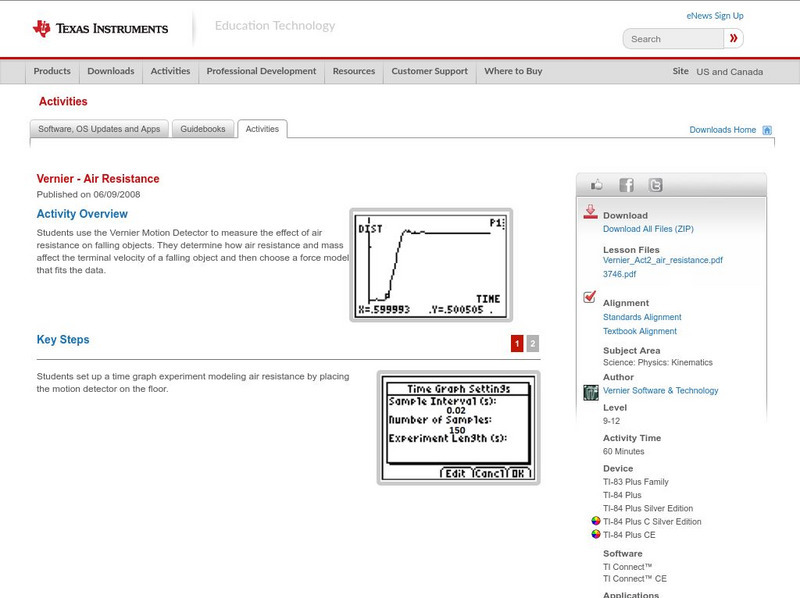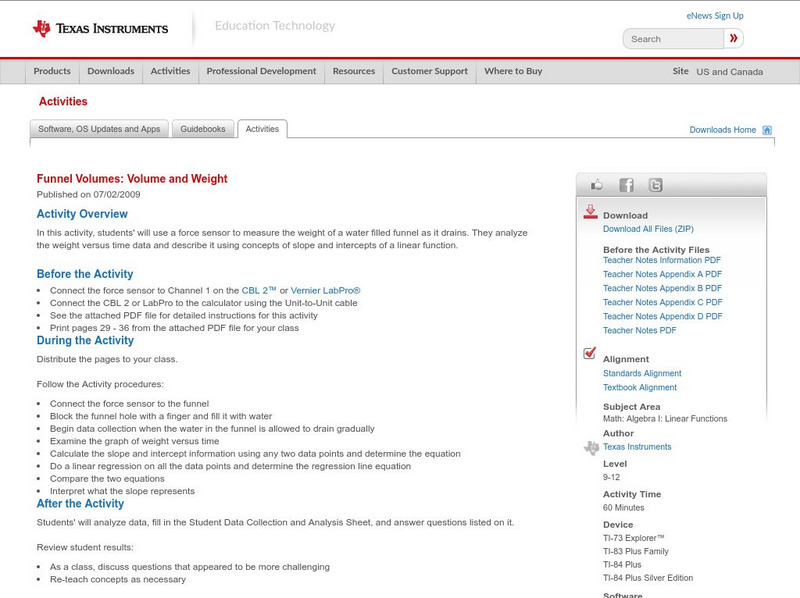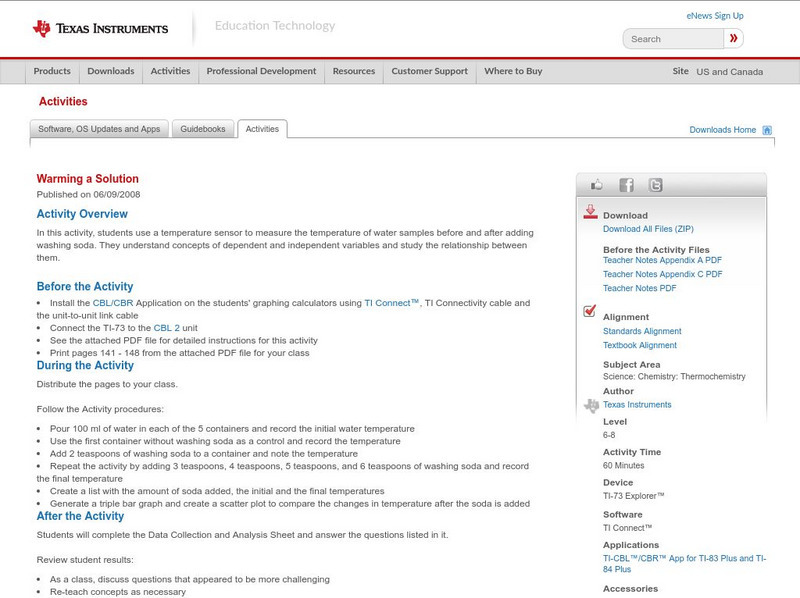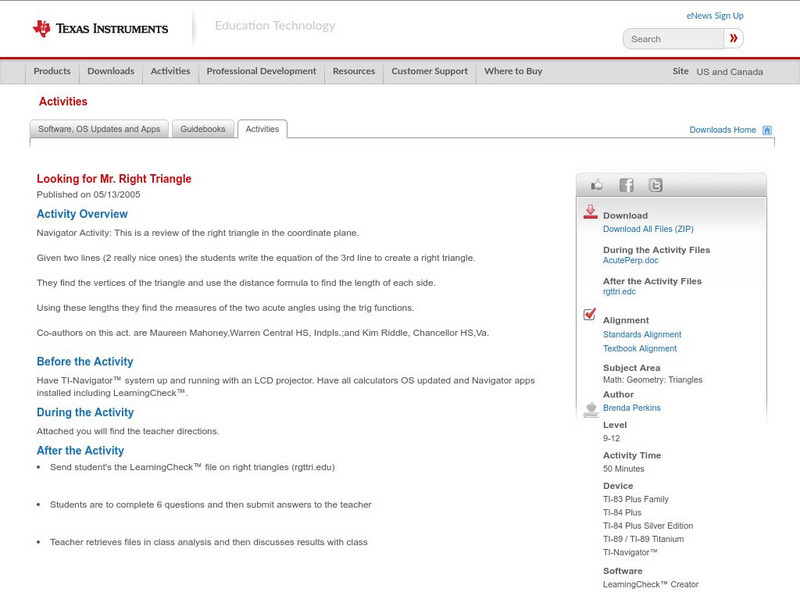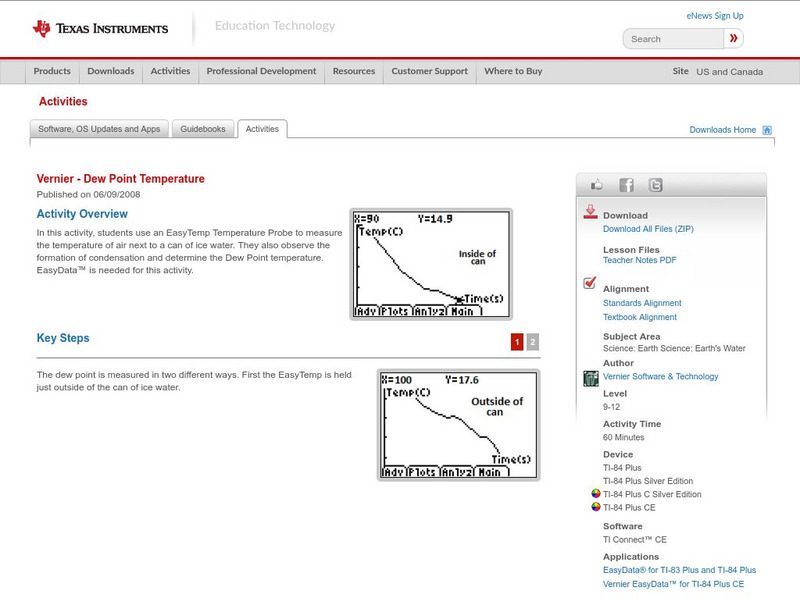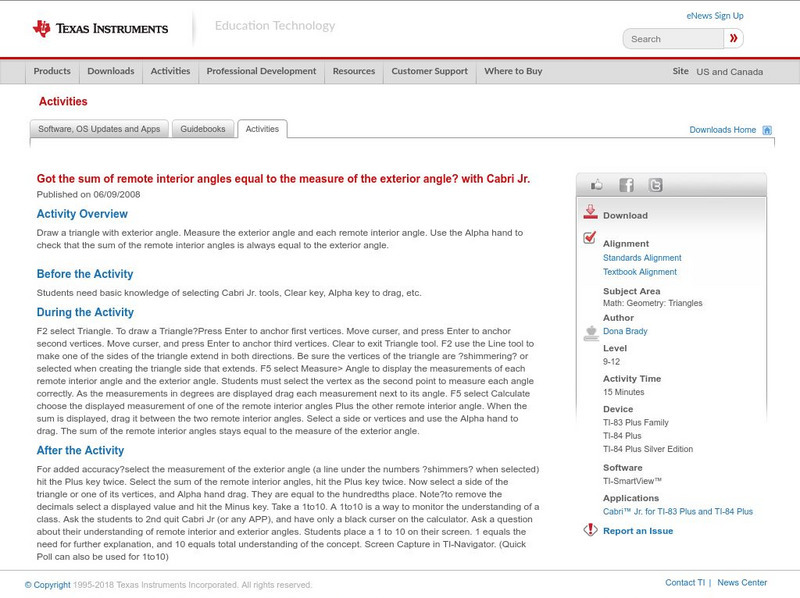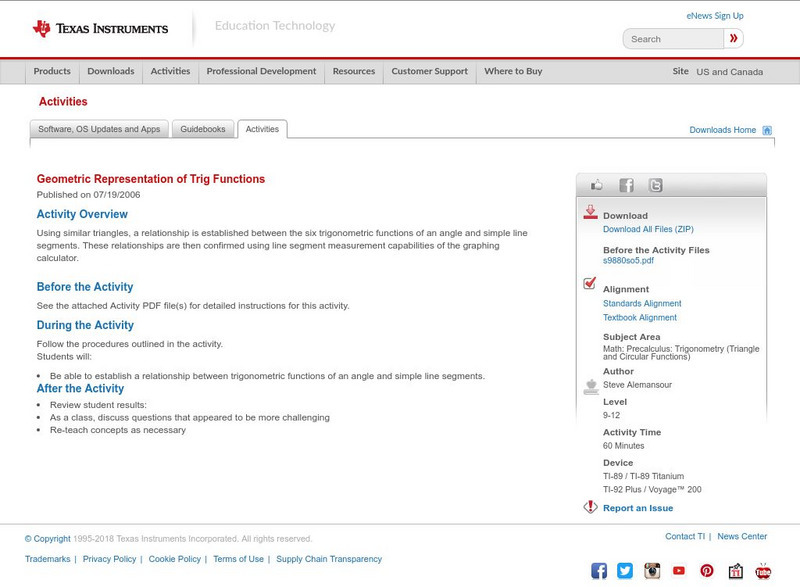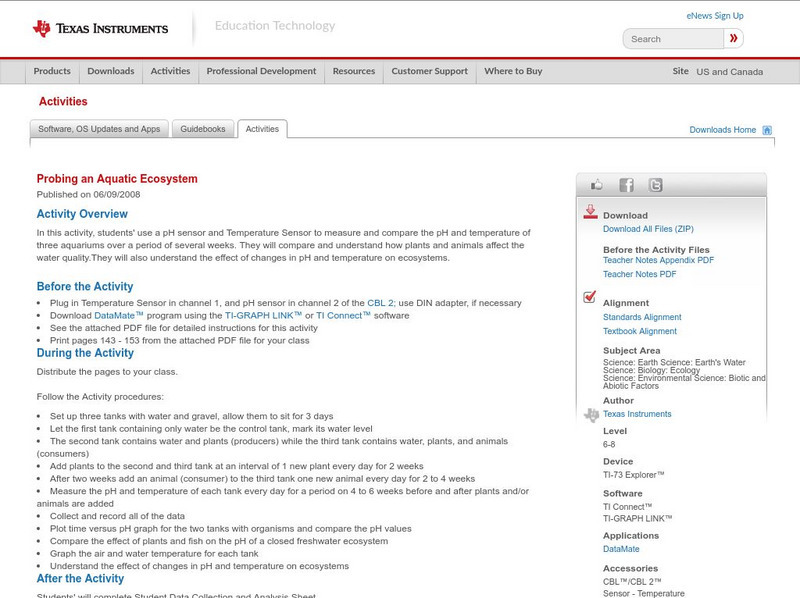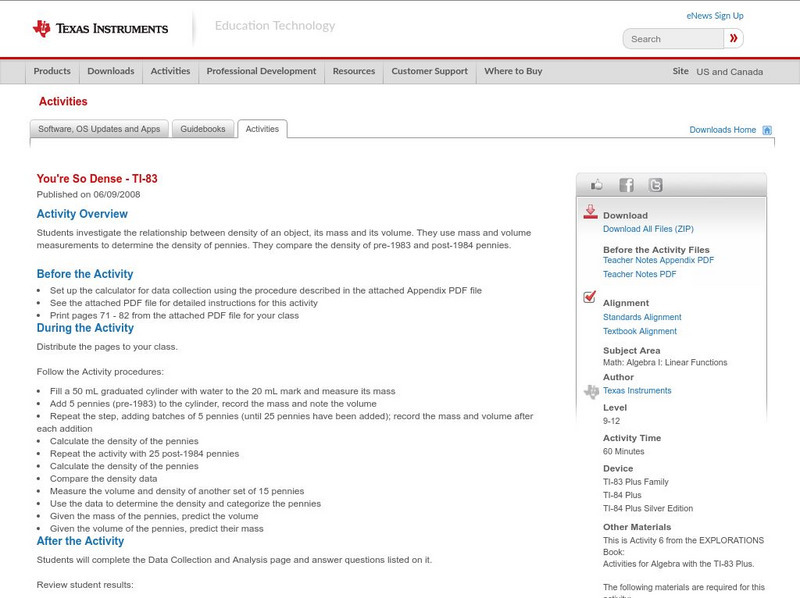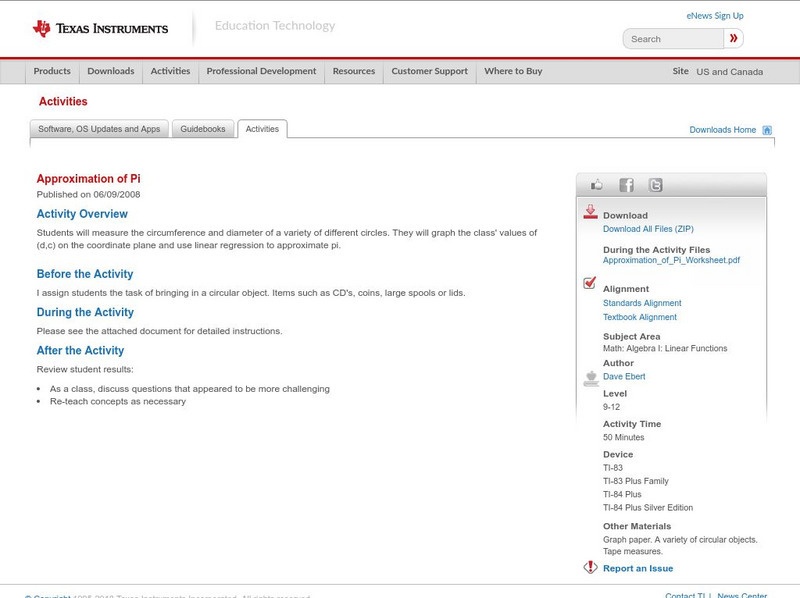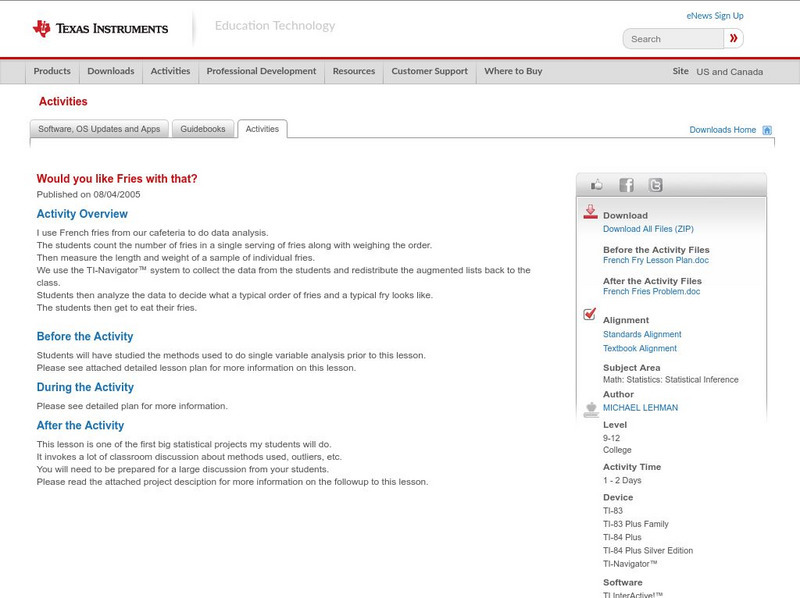Texas Instruments
Texas Instruments: Electrolytes: Which Liquid Produces the Most Volts?
In this activity, students' will use a Voltage Sensor to measure the voltage produced by an electrolyte. They will understand that acids and bases are electrolytes and compare voltages of acids to the voltages of bases. Students' will...
Texas Instruments
Texas Instruments: Air Resistance
Students use the Motion Detector to measure the effect of air resistance on falling objects. They determine how air resistance and mass affect the terminal velocity of a falling object and then choose a force model that fits the data.
Texas Instruments
Texas Instruments: Glencoe Mid. School Science: Effect of Acid Rain on Limestone
Students will collect rainwater and measure its acidity. They will use the rainwater to determine the effect that acid rain has on limestone.
Texas Instruments
Texas Instruments: Funnel Volumes: Volume and Weight
In this activity, students' will use a force sensor to measure the weight of a water filled funnel as it drains. They analyze the weight versus time data and describe it using concepts of slope and intercepts of a linear function.
Texas Instruments
Texas Instruments: Warming a Solution
In this activity, students use a temperature sensor to measure the temperature of water samples before and after adding washing soda. They understand concepts of dependent and independent variables and study the relationship between them.
Texas Instruments
Texas Instruments: Grandparents and Special Friends Day
This lesson was designed for our Grandparents and Special Friends day. It can be used for any visitation day, or an open house. The lesson is designed to review percent of a whole and the sector of the circle representing the percentage....
Texas Instruments
Texas Instruments: Dissolved Oxygen
Students use the Dissolved Oxygen Probe to measure the concentration of dissolved oxygen in water from streams and rivers. They correlate the availability of dissolved oxygen to temperature, pressure, and salinity.
Texas Instruments
Texas Instruments: Forensics Case 8: Using Soil Characteristics to Link Suspects
In this activity, students measure pH, conductivity, and water absorbency of different samples of soil. They use these characteristic properties to identify soil samples. They use the physical and chemical characteristics of soil samples...
Texas Instruments
Texas Instruments: Treasure Trove
In this activity, students use a Dual Range Force Sensor to measure the weight of pennies. They understand the difference between mass and weight. Students also determine the difference in weight of an object on the moon, Mars, Saturn,...
Texas Instruments
Texas Instruments: Conductimetric Titration & Gravimetric Determination
Students use a Conductivity Probe to measure change in conductivity during a chemical reaction and determine the equivalence point of the reaction They determine the mass of the product and calculate the molar concentration of the...
Texas Instruments
Texas Instruments: Looking for Mr. Right Triangle
Navigator Activity: This is a review of the right triangle in the coordinate plane. Given two lines (2 really nice ones) the students write the equation of the 3rd line to create a right triangle. They find the vertices of the triangle...
Texas Instruments
Texas Instruments: Dew Point Temperature
In this activity, students use an EasyTemp Temperature Probe to measure the temperature of air next to a can of ice water. They also observe the formation of condensation and determine the Dew Point temperature. EasyData is needed for...
Texas Instruments
Texas Instruments: Jason: Tracking the Path of Animals
Rainforest at the Crossroads: Simulate the motion of an animal using a rectangular object placed at different positions on the floor. Then measure and graph the animal's coordinates, and examine its path.
Texas Instruments
Texas Instruments: Sum of Remote Interior Angles Equals Exterior Angle
Draw a triangle with exterior angle. Measure the exterior angle and each remote interior angle. Use the Alpha hand to check that the sum of the remote interior angles is always equal to the exterior angle.
Texas Instruments
Texas Instruments: Geometric Representation of Trig Functions
Using similar triangles, a relationship is established between the six trigonometric functions of an angle and simple line segments. These relationships are then confirmed using line segment measurement capabilities of the graphing...
Texas Instruments
Texas Instruments: Triangle Sum
This activity is used to discover that the sum of the measures of the triangle angles is constant and to discover ways of proving the theorem listed in the activity.
Texas Instruments
Texas Instruments: Probing an Aquatic Ecosystem
In this activity, students' use a pH sensor and Temperature Sensor to measure and compare the pH and temperature of three aquariums over a period of several weeks. They will compare and understand how plants and animals affect the water...
Texas Instruments
Texas Instruments: You're So Dense Ti 83
Students investigate the relationship between density of an object, its mass and its volume. They use mass and volume measurements to determine the density of pennies. They compare the density of pre-1983 and post-1984 pennies.
Texas Instruments
Texas Instruments: Comparing Sunscreens
In this activity, students use the UVB Sensor to measure the amount of UVB light that passes through a thin film of sunscreen. They analyze the relationship between the SPF values and the intensity of UVB light transmitted by the sunscreen.
Texas Instruments
Texas Instruments: Real Life Real World Activity Carpentry
Carpenters use applications of geometry in their work, including the properties of right triangles and circles. This activity uses Cabri Jr. Geometry software to make measurements and solve problems based on carpentry situations....
Texas Instruments
Texas Instruments: Reflectivity of Light
In this activity, students can use a Light Sensor to measure reflection values from paper of various colors and compare these values to reflection values of aluminum foil. They will also calculate percent reflectivity.
Texas Instruments
Texas Instruments: Approximation of Pi
Students will measure the circumference and diameter of a variety of different circles. They will graph the class' values of (d,c) on the coordinate plane and use linear regression to approximate pi.
Texas Instruments
Texas Instruments: Points on the Perpendicular Bisector of a Segment
In this activity, students use the drawing and measurement tools of Cabri Jr., to learn and understand the concept of "equidistant from the endpoints of a segment." They observe the changes if they move a point on the perpendicular...
Texas Instruments
Texas Instruments: Would You Like Fries With That?
French fries from your cafeteria to do data analysis. The students count the number of fries in a single serving of fries along with weighing the order, then measure the length and weight of a sample of individual fries. You then use the...

